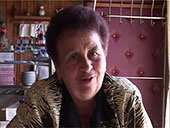
Rita Shveibish was born in 1936 in Tulchyn. She grew up with two brothers. Both of her parents were born in Tulchyn. Her father delivered products for a welding shop. She survived the war in Pechera. After the war, she trained in Vinnytsya as a nurse, and worked as a nurse for fifty years in Tulchyn. Since her retirement, she has been director of the Jewish community of Tulchyn and has been active in establishing memorials for the murdered Jews of the town.
Other Interviews:
Bessarabian and Bukovinian JewsInside the Camp
Tulchyn, Ukraine
In December 1941, the Jews of Tulchyn, who had been languishing in the city’s ghetto for the first months of the war, were ordered to report for disinfection and relocation. After a forty kilometer forced march over two days--during which many died en route--about 3000 Jews from the city eventually arrived in the town of Pechera, where, set on a cliff overlooking the Southern Bug River and surrounded by parkland was a three-story Romanesque palace that had once belonged to the Potocki noble family, but had been used as a sanatorium for tuberculosis patients by the Soviet government.
The Jews of Tulchyn and surrounding towns were dumped in the building and left to their own devices. This was not a labor camp nor technically a death camp—although death rates were exceedingly high. Rather, it was simply a de facto concentration camp.
Over the course of the next months, additional shipments of Jews were brought into the camp, including about 750 Jews from Bratslav who were brought to the camp in January 1942, and several hundred more who arrived over the next few days from Ladyzhyn and Vapnyarka. Sporadic deportations into Pechera continued over the summer and fall: about 3,500 Jews from the Mohyliv-Podilskyy ghetto were deported to Pechera in two waves in July and October–November 1942. Many inmates of the camp were Bessarabian and Bukovinian Jews, whose long forced exodus from their homes in Romania finally ended here. In total about 9,000 Jews were held in Pechera.In this clip, Rita Shveibish, a child survivor herself and local amateur historian, describes the forced march to the camp and some of the conditions in the camp.
Source: Jeffrey Veidlinger, In the Shadow of the Shtetl: Small-Town Jewish Life in Soviet Ukraine (Indiana University Press, 2013)
